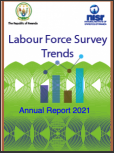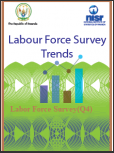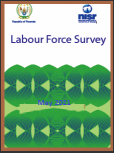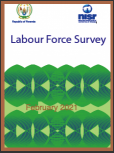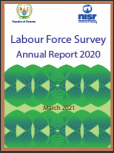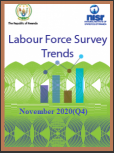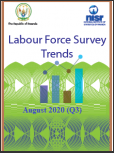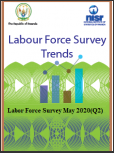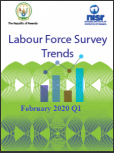Labour Force Survey Annual Report 2021
The annual Labour force Survey is derived from a consolidated or pooled data from four quarters of year. Rwanda redesigned LFS from bi-annual to quarterly basis since February 2019 to provide estimates of labour market indicators and monitor labour market trends on a quarterly basis.
Labour Force Survey Trends-November 2021(Q4)
The Labour Force Survey (LFS) programme collect data on employment and labour underutilization characteristics of the population on a continuous basis, providing quarterly estimates of the main labour force aggregates with sufficient precision at the National level since 2016.
Labour Force Survey Trends-August 2021(Q3)
The Labour Force Survey (LFS) programme collect data on employment and labour underutilization characteristics of the population on a continuous basis, providing quarterly estimates of the main labour force aggregates with sufficient precision at the National level since 2016.
Labour Force Survey Trends-May 2021(Q2)
The Labour Force Survey (LFS) programme collect data on employment and labour underutilization characteristics of the population on a continuous basis, providing quarterly estimates of the main labour force aggregates with sufficient precision at the National level since 2016.
Labour Force Survey Trends-February 2021(Q1)
The Labour Force Survey (LFS) programme collect data on employment and labour underutilization characteristics of the population on a continuous basis, providing quarterly estimates of the main labour force aggregates with sufficient precision at the National level since 2016.
Labour Force Survey Annual Report 2020
The Rwanda Labour Force survey programme begun in 2016 with an annual sample spread into two rounds to provide bi-annual estimates of main indicators at the National level. From February 2019, the annual sample was spread into four rounds to provide estimates of main labour market indicators on quarterly basis at the National level. This specific report pull together different rounds of the labour force survey conducted within a specific year namely February, May, August and November.
Labour Force Survey Trends-November 2020(Q4)
The Labour Force Survey (LFS) programme collect data on employment and labour underutilization characteristics of the population on a continuous basis, providing quarterly estimates of the main labour force aggregates with sufficient precision at the National level since 2016.
Labour Force Survey Trends-August 2020(Q3)
The Labour Force Survey (LFS) programme collect data on employment and labour underutilization characteristics of the population on a continuous basis, providing quarterly estimates of the main labour force aggregates with sufficient precision at the district level.
Labour Force Survey Trends-May 2020(Q2)
The ultimate goal of Labour Force Survey (LFS) programme is to collect data on employment and labour underutilization characteristics of the population on a continuous basis, providing quarterly estimates of the main labour force aggregates with sufficient precision at the district level.
Labour Force Survey Trends-February 2020(Q1)
In February 2020(Q1), the working age population (16 years and above) was around 7.4 million and the population in the labour force constituted the majority of working age population. The proportion of population who were in the labour force increased from 52.5 percent in February 2019 to 55.6 percent in February 2020. The proportion of the working age population outside the labour force slightly decreased in the first quarter of 2020 as compared to different quarters of the LFS in 2019.

